Beautiful Plants For Your Interior
How to Grow Cucumbers – 4 Tips to Success
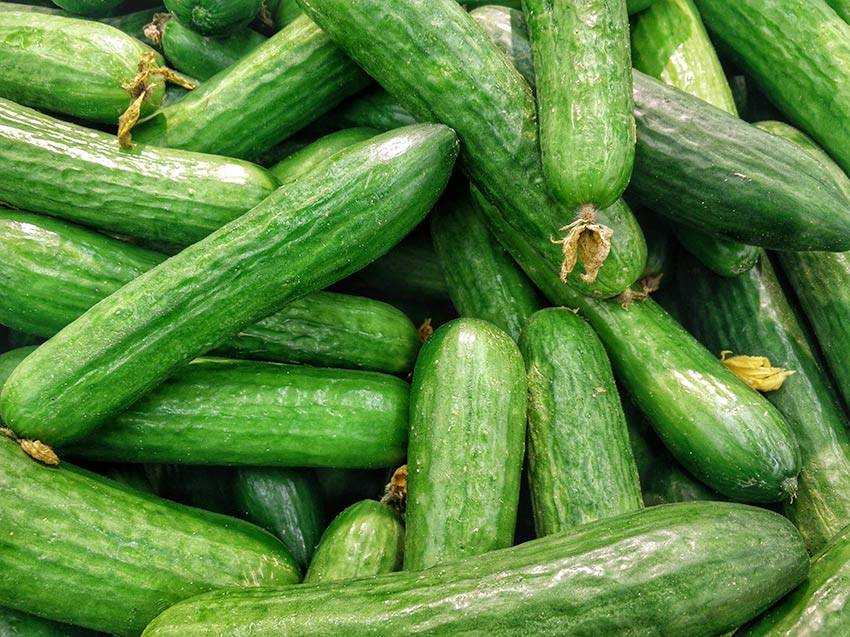
Everything about sowing, caring for and harvesting cucumbers. How do cucumbers grow? With cucumbers being a staple in many summertime foods, growing one’s own is the perfect way to ensure that they are fresh and crisp. Many people enjoy cooking with them – from salads to making drinks taste refreshing on hot days when you just can’t get enough of their cool crunch.
It is easy to grow cucumber plants from seed in your own garden or even on small patios or balconies. You can also choose from varieties of different lengths; some produce smaller fruits you could eat fresh while others should be pickled if you want them to last longer.
There are two types of cucumbers, greenhouse and outdoor types. Greenhouse cucumbers need plenty of heat to grow, so they can only be grown in a greenhouse or polytunnel.
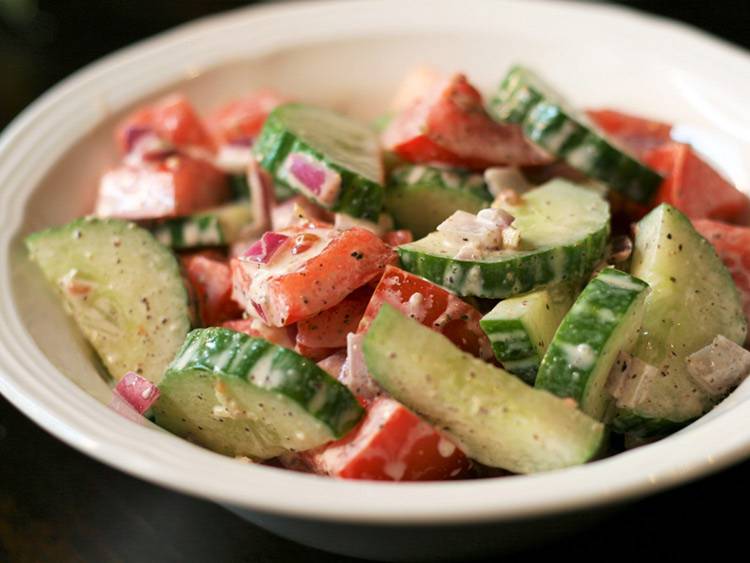
How to Grow Cucumbers: Cucumbers Are Tasty in a Summer Salad
Cucumbers are large plants that produce long smooth fruits, which is similar to the ones sold at your local supermarket. This type doesn’t need pollinating because the male flowers must be removed for the cucumbers not to become bitter with too many seeds inside due to pollination.
There are some special greenhouse hybrids too that will just produce female blooms, like the F1 (Filial 1) greenhouse variety ‘Bella’ which only bears female flowers.
Cucumbers can grow in many different conditions, but if you’re looking for a hardier variety that can tolerate lower temperatures then try out the ‘ridge’ type. Outdoor or ridge cucumber plants are shorter and fatter with rough ridged skin.
The flowers on these varieties are pollinated by insects so both male and female types must be present for pollination! Some varieties have trailing stems which makes them ideal for training up supports. Other ‘bush’ types will stay upright better, giving opportunities to grow in smaller gardens and or areas such s patios or balconies.
However, no matter what kind of cucumber plant it is though, make sure not to put any outside ridge type next to greenhouse ones as this will result in cross-pollination and bitter, seed-filled fruits.
How to Grow Cucumbers: Sowing
Whether you’re growing indoors or outdoor cucumbers, sowing seeds needs to be done in late winter or early spring, alternatively buy young plants at your local garden centre in late spring.
If you are growing cucumbers outdoors, don’t forget to ‘harden’ them off so they are used to the outdoor conditions.
Indoors
The best time for sowing cucumber seeds indoors is in late winter or early spring. Sow cucumber seeds vertically on their side, 1–2cm (½–¾in) deep into pots of peat-free multipurpose compost and keep the temperature at least 20ºC to germinate. Use a heated propagator or place pots on a warm sunny windowsill.
To grow cucumber plants, you need only two seeds per pot. Plant them, then water the compost and wait 7-10 days to see if your seedlings emerge! Once they start showing themselves it is time to ‘remove’ one of the weaker ones leaving one in the pot. When the seedlings have developed their first set of large leaves they are ready to be transplanted into a 3.5in (9cm) pot for more growth.
Outdoors
One of the simplest ways to grow cucumbers is by sowing the seeds directly in their growing location, like a raised bed. The best time for this is around late May or early June when all risk of frost has passed.
To make sure your plants grow strong and healthy, cover them with either a ground fleece, a garden cloche (a type of dome-shaped covering), or even an old glass jar as soon as you ‘sow’ those precious seeds outside.
Fortunately, this method can work well in the southernmost counties in the UK and during warmer weather. In fact, young plants are even available from some garden centres in spring, for a more timely harvest!
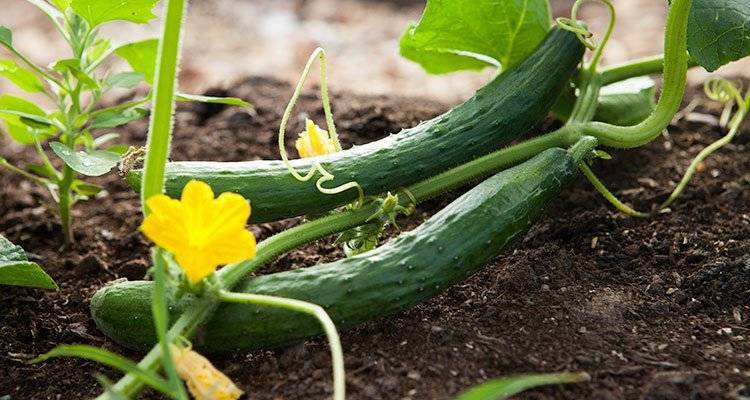
How to Grow Cucumbers: Growing Cucumbers Outdoors is Easy as Long as You ‘Sow’ The Seeds When all Risk of Frost is Gone.
How to Plant Cucumbers: Growing
Growing in a Greenhouse
Maintaining a good temperature is crucial to the growth of cucumber plants. They need an environment that ranges between 21 and 29°C (70-84°F).
Young plants are generally transplanted into 25cm (10in) pots in March if grown in a ‘heated’ greenhouse or in late May in an ‘unheated’ greenhouse; this helps them grow strong roots if you plan to place them outside later on because established root systems can endure lower temperatures better than new ones can.
Start with rich soil, water it well, and plant seedlings out when they have two or three leaves. They can be planted into greenhouse borders that are enriched with plenty of garden compost – 2ft (60 cm) apart from each other, or in growing bags – two plants per bag is a great idea!
If you’re looking for an alternative way of planting them, then try large containers filled up with peat-free multi-purpose compost. Train the main stem upwards using any material such as bamboo cane wire, string trellis etc.. Tie if necessary.
Finally, water your plants carefully and often to keep the potting compost or soil evenly moist. Increase the humidity in the greenhouse in hot weather, this can be done by watering the floor so that the moisture evaporates creating a nice gently humid environment.
Make sure you feed them every 10-14 days with a balanced liquid fertiliser
Growing Outdoors
For outdoor ‘ridge’ cucumbers, a week before planting them outside make sure the plants are strong and ready for warmer weather by hardening them off.
Plant outside in late May or early June when it’s warm enough. Place your plant where there is plenty of sun and shelter with well-rotted manured and or good garden compost to provide the nutrients they need.
You can also train the main stem up a support leaving side shoots trailing along the soil or up a wire mesh. Allowing around 36in (90cm) or so space between each other if necessary.
It might be tempting to grow cucumbers in a greenhouse but beware. Never grow ‘outdoor’ ridge cucumbers in a greenhouse as an all-female variety as cross-pollination occurs, and your fruits will taste bitter.
Finally, when the cucumber plants have developed several leaves, pinch out their growing tips. The developing side shoots can be left to trail over the ground or ‘trained’ up as described above; you also pinch out the tips of flowerless side shoots after seven leaves.
Don’t remove male flowers though – those are needed!- but keep soil always moist by watering around instead of right on top so as not to disturb the plant.
How to Grow Cucumbers: Male or Female?
We have talked a lot about male and female plants, but how do we know which is which? You can tell them apart as female flowers have a small immature swelling fruit behind the flower, whereas the male ones do not, but have a normal stem.
There are several disease-related problems associated with growing cucumbers within a greenhouse especially out in the garden. Some of the common ones are listed below.
Whitefly:
The ‘Whitefly’ is a tiny white insect that can prey on greenhouse-grown cucumbers. The ‘honeydew’ these bugs produce causes the growth of black, sooty mould which damages healthy plant growth and decreases production yield.
Solution:
Use commercially available pesticide-free biological controls and or double-sided sticky traps in the greenhouse.
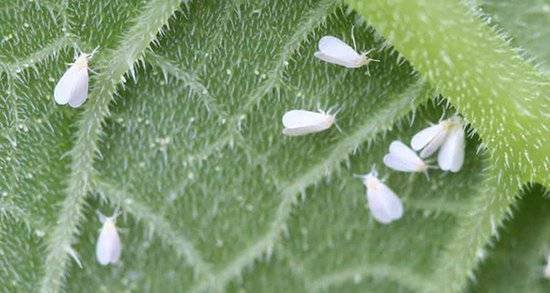
How to Grow Cucumbers: Whitefly Can Cause Serious Damage to Greenhouse-Grown Cucumbers.
Cucumber Mosaic Virus:
This is a bad one. The plants and leaves are stunted and deformed, with a distinctive yellow mosaic pattern on them. The flowers, if any at all are withered any fruit that does appear is small, pitted, hard and inedible.
Solution:
The disease is spread by sap-sucking aphids, so all measures should be taken to control these initially.
There is no treatment or remedy available for this virus, unfortunately, all you can do is destroy any infected plants; otherwise further spreading of the disease would be inevitable.
Avoid any consequences and wash your hands after touching infected plants to avoid contaminating other healthy plants.
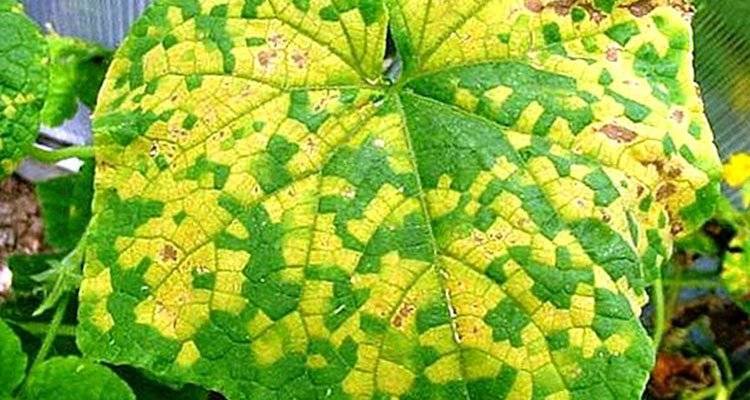
How do Cucumbers Grow: Cucumber Mosaic Virus Has Distinctive Yellow Mosaic Patterning on the Leaves.
Powdery Mildew:
One of the most common causes of disease in cucumbers is ‘Powdery Mildew’ which is often a sign of under-watering.
Leaves have white powdery patches on leaves that can shrivel and eventually die if not cared for properly, although there are cultivars available that are better suited to dryer climates and don’t seem susceptible to leaf damage like this!
Solution:
It’s best to keep the soil moist, but not wet by watering deeply every few days with deep soaks rather than frequent shallow sprinkles that do more harm than good.
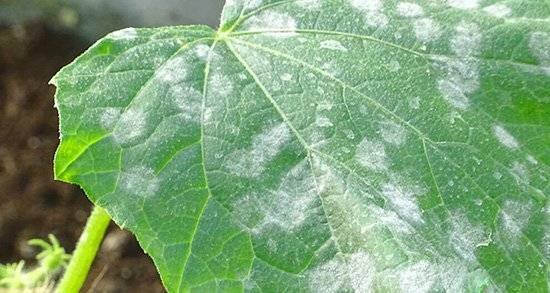
How do Cucumbers Grow: Powdery Mildew is Often a Consequence of Under-Watering.
Harvesting
The time to harvest cucumbers varies depending on your location, what type of variety you grow and where.
When harvesting them from outdoors in midsummer, start harvesting after about 12 weeks from sowing. Beware though, don’t wait too long because their skin can get tough and mature varieties may taste bitter if left out past September!
If growing greenhouse fruiting plants you can continue on through mid to late October as long as the warm weather continues.
You’ll want to know the variety of your fruit before planting, as it will have an effect on how big they grow. Smaller fruits are best harvested when they are about 10 cm (4in) long while larger varieties should be 15-20cm (6-8 in).
Cucumbers need to be green and firm with a rounded tip when you get them at their peak freshness! You can harvest these regularly for continued fruiting if needed too. If any turn yellowish or soft then better think twice because that means they’re overripe.
How to Grow Cucumbers – How do Cucumbers Grow? From Sowing to Harvesting
Recommended Varieties of Cucumbers to Try
From The Greenhouse
F1 Bella:- F1 Bela is a beautiful female flower variety that can be grown in an unheated greenhouse. Bella produces long fruit 13in (35cm) that are tasty and crisp fruits and not bitter. Bella also has a high vitamin content, just perfect for salads. Bella also has a good tolerance to diseases such as powdery mildew.
F1 Delistar:- F1 Delistar is a new and unusual variety of cucumbers with thin, pale green skin that is so translucent you don’t even need to peel them.
F1 Mini Munch:- F1 Mini Munch is an all-female variety, producing 3in (7cm) fruits. They may be smaller but they are very tasty fruits. The perfect lunch box snack, with a mid-green colour, gives it a subtle and enticing look that is smooth to the touch with no spikes or spines. Multiple fruits per node give this plant longevity, so you can enjoy its fruits over the entire summer!
Outdoor Varieties
Marketmore:- This ‘ridge’ cucumber has a trailing habit, which makes it ideal for outdoor growing. The male flower should not be removed because of the good yield Marketmore provides. The fruits are short, attractive, and dark which are typical of this variety.
Venlo Pickling:- This ‘ridge’ (outdoor) cucumber, is known for its tender skin and excellent flavour, which makes it perfect for pickling and also when used in salads.
Bush Champion:- Short on space? Bush Champion is great for pots, containers or raised beds or space is limited. Provides high yields and has a good crunch and taste.
Best of Both Worlds Greenhouse and or Outdoor Varieties
F1 Burpless Tasty Green:- The perfect cucumber for beginners providing crisp, fresh texture and taste with absolutely no bitterness. This cucumber is a very popular variety that can be easily grown both indoors and outdoors in pots.
It produces 10in (25cm) long fruits, which are high-vitamins. One of the most reliable cucumbers you can grow. Generous harvests of fat, firm ridge cucumbers from early in the season until the first frosts.
La Diva:- The succulent and sweet-tasting cucumbers of this all-female cucumber plant, produces chunky, seedless fruit. La Diva can be grown indoors or outdoors with little effort. This variety has a good tolerance level for cooler climes.
Crystal Lemon:- A novel variety, that produces very tasty round yellow fruits Can be grown against a support such as a trellis, archway, or wigwam or if preferred, can be simply left to trail along the ground. Can be grown in a vegetable plot, raised beds or a container garden.
The RHS advises they are perfect for bees and other pollinators.
FAQs
How Long Do Cucumbers Take to Grow
Cucumbers typically take between 50 and 70 days to grow from seed to harvest.
How do You Fertilise Cucumber Plants?
Here are a couple of tips for fertilising cucumber plants:
Use a balanced fertiliser: Cucumber plants require a balanced fertiliser that contains equal amounts of nitrogen, phosphorus, and potassium. A ratio of 10-10-10 is ideal.
Apply fertiliser at the right time: Cucumber plants should be fertilised when they are actively growing, usually two to three weeks after planting. Over-fertilising can lead to excess foliage growth and reduced fruit production.
What Are The Ideal Growing Conditions For Cucumbers?
Cucumbers are warm-season plants (do we get that in the UK, sometimes) that require specific growing conditions to thrive. Here are some factors to consider when growing cucumbers:
Temperature: Cucumbers thrive in warm temperatures, between 21 and 29°C. Anything lower than 16°C can stunt their growth, and temperatures over 32°C can cause the fruit to become misshapen.
Soil: Cucumbers grow best in well-drained, fertile soil that is rich in organic matter.
A pH range of 6.0 to 6.8 is ideal for cucumber growth.
Sunlight: Cucumbers require at least six to eight hours of sunlight a day.
Conclusion
We hope you’ve found this post interesting and informative. It should give you all the information on how to sow, care for and harvest cucumbers that a UK grower could need! To recap, our ‘How to grow cucumbers’ post. Here are our top tips for growing cucumbers in the UK.
First, plant them early so they can grow all season long and last through winter if necessary.
Second, make sure to water regularly as this will help create a healthy crop of cucumbers that stay fresh longer.
Third, harvest when you see any flowers forming on the vine or fruits start to turn yellowish green; do not wait for your cucumbers to become over-ripe before harvesting!
Finally, don’t forget about fertilizer – it may be time to add some more organic matter like compost into the ground around your plants (again) depending on how old your garden is… And there you have everything you need to know about sowing, caring for and harvesting cucumbers.
If this post has helped you in any way, please share it amongst your family and garden-loving friends or anybody looking to know ‘how to grow cucumbers‘.
Finally, you can always pop over to our FAQ page to find out more about cucumbers and a whole host of other answers to your gardening questions and queries.
